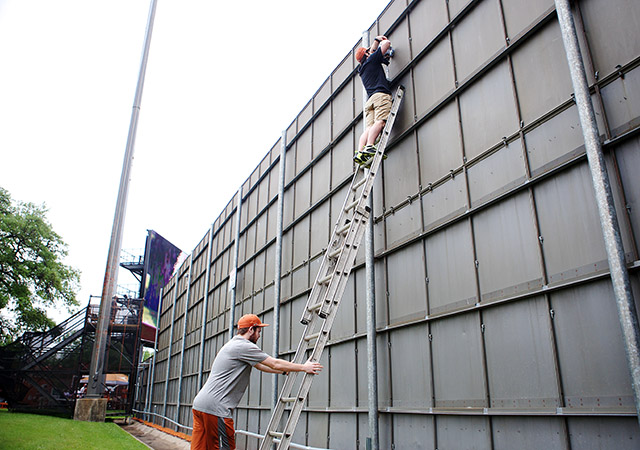Digital Dugout Helps Texas Players See What They Are Missing

Keith Allen secures a ladder so Reed Hauser can mount a video camera on the centerfield wall at Disch-Falk Field. The students are members of the video team for the University of Texas at Austin baseball program. Photo by Kiera Dieter/Reporting Texas
By Claire Cruz
For Reporting Texas
The eyes of Texas baseball start work two hours before the first pitch.
Ryan Monsevalles, Hunter Wade and Reed Hauser arrive at Disch-Faulk Field to update statistics for the University of Texas and its opponent that day. They set up three cameras: one in each dugout and the third in center field, all aimed at the pitcher’s mound. Then they film every pitch.
Monsevalles, a 2014 sports management graduate from San Benito, has been the team’s video manager since 2012. He, Wade and Hauser, both juniors at UT, give Longhorn players and coaches extensive, accessible video records of each game.
For Monsevalles, the video manager role fulfills his dream of being part of a successful college baseball program. He or his video counterparts document every scrimmage and game to ensure that players can see their mistakes and successes, make adjustments and improve.
“The significance of our roles is a direct reflection of the pride we take in our work,” Monsevalles said. “We take pride in what we do, because we know it’s all bigger than ourselves.”
As technology has advanced, student managers in collegiate sports have grown in importance. Many programs now employ students who are more like scouts than equipment managers.
The University of Virginia’s baseball student managers, for example, are in charge of a new $325,000, Major League Baseball-level video system. It’s identical to the one the Miami Marlins use — eight cameras and two 60-inch televisions to edit the video. Texas’ system has been in place for five years and cost roughly $5,000 to implement. It takes the student managers roughly an hour to get everything ready and uploaded to a custom website; Virginia’s system gets it done in 15 minutes.
“The video managers provide us with pivotal information that we use to constantly improve throughout the season,” said junior Travis Duke, a pitcher from Pearland.
Video managers work like movie directors.
The dugout cameras are positioned to record the hand movements, footwork and weight displacement of pitchers and hitters. Opposing teams are allowed to set cameras up as well.
The camera in the outfield focuses on the pitcher’s mound and batter’s box to record other angles of mechanics and pitch location. Monsevalles climbs a ladder about 10 feet high to secure the camera in a clear plastic box.
“The first time I had to do this, I was terrified,” Monsevalles said. “But you get used to it. Just don’t look down.”
Once the cameras are set up, Monsevalles and Wade sit in the fourth row behind home plate.
Monsevalles uses an iPad and an application called ESPN iScore to keep records of the game. Wade uses a radar gun to track pitch speeds. At the request of pitching coach Skip Johnson, they document every pitch, including the speed and location and whether it’s a ball or strike. A “pitch sheet” shows how many times a certain pitch is thrown and at what speed.
“They give all of the pitchers sheets after each time we pitch, so we have statistics on our performances, and it helps tremendously,” said senior Parker French, a pitcher from Dripping Springs.
Monsevalles documents every time the ball is put into play. He keeps track of what the base runners did, who fielded the ball and where he threw it.
Throughout the game, Monsevalles sends signals to the dugout to relay pitch speeds. When Texas is batting, hitters look to him to get an idea of how fast the pitches are coming.
Monsevalles uses his fingers to signal how much under or over 90 miles per hour the previous pitch came in – four fingers down for 86 mph, one finger up for 91.
After the game, Monsevalles and Wade rush from the stadium to the clubhouse film room, where they upload the video on software called Dartfish. They also export the information from the iScore application onto a website called Inside Edge.
They edit the film and keep only the angles that display the chest of the Texas hitters and pitchers. They also interlace the video with time stamps for each pitch.
A pitcher will have a list of every pitch he threw, a video of the pitch and the outcome. This allows the pitchers and coaches to find and correct delivery flaws.
“I definitely feel like the information they provide has helped me personally,” Duke said. “Once I was throwing a bullpen with (Johnson) and he was trying to describe to me what I was doing wrong, but I couldn’t tell until he showed me the film on myself that the video managers had taken.”
Problems sometimes arise.
After Texas’ home opener against UT-San Antonio on Feb. 17, Monsevalles, Wade and Hauser had to stay in the film room for more than two hours because of a problem with Dartfish. The software updated itself and caused settings to change, which the video managers didn’t know about.
Other times, they will encounter a software glitch when uploading a video, and they have to begin the process all over.
“You run into problems, but they’re good problems to have,” Monsevalles said. “I’m lucky to have the opportunity to stay up late trying to get work done for Texas baseball. It’s been the best job I’ll ever have.”